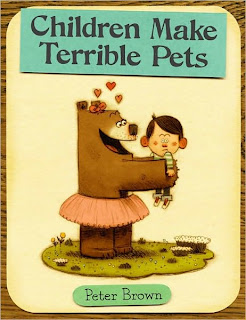
Mo Willems is a distinguished writer and illustrator whose career began as an animator and illustrator for Sesame Street. Since then, he has acquired 3 Caldecott Honors, 2 Geisel Medals, 2 Carnegie Medals, 6 Emmys, a Geisel Honor and several Bubble Gum Cards. His 2005 Caldecott Honor book, Knuffle Bunny: A Cautionary Tale addresses the attachment a toddler has to her beloved stuffed animal and the responsibility parents are obliged to uphold in making sure that this attachment is not prematurely severed.
Young Trixie goes on an errand with her Dad to the Laundromat. She takes along her precious Knuffle Bunny but manages not to return with it on her way back home. While Trixie cannot coherently convey that Knuffle Bunny is missing because she is too young, she adamantly makes it clear that something is wrong through her actions; screaming, crying – just generally being difficult. When Trixie and her father return home and Trixie’s mother opens the door, Trixie’s mom instantaneously asks, “Where’s Knuffle Bunny?” The family rushes back to the Laundromat to find Knuffle Bunny still intact from being in the washer.
Knuffle Bunny: A Cautionary Tale is a charming story that is an adaptation of traditional stories about friendship. Trixie has developed what some parents may consider an unhealthy obsession with a stuffed animal but at such a young age, we understand that that will eventually pass. Most children can probably identify with Trixie’s attachment although it may have taken a different form (such as a blanket). So, this book exudes a certain element of identification or nostalgia. The illustrations in Knuffle Bunny juxtapose grayscale/sepia images of a neighborhood in Brooklyn (Brooklyn stand up! – I’m a native) with vibrant, rich and outstanding artistic images of the elements that move the book along (like Trixie and her Dad walking down the street). Children will find it easy to concentrate on the plot of the story because the imagery literally jumps right up at you because of the color contrast. The illustrations make for comprehensible and believable emotions as well as an appropriate setting to use as a canvas.
Children will fall in love with this story and parents will sympathize with Trixie’s parents. Willems has a distinct and catching style that will surely leave you yearning for more. Lucky for us, Knuffle Bunny: A Cautionary Tale is a three part series to satisfy the itch of wanting to know what will become of Trixie and her beloved bunny.










 “Tony Baloney is a macaroni… penguin” are the first words to the fun and energetic story of Tony’s life. Pam Munoz Ryan and Edwin Fotheringham take the reader on the adventures of Tony’s daily life, learning about his likes (fish tacos with parmesan cheese) and his dislikes (trouble), as well as his family life. As the only boy in the family of macaroni penguins, Tony is also stuck in the middle. Tony does not like to play with his twin, baby sisters (also known as the Bothersome Babies Baloney) and his only option is usually playing with his older sister (Big Sister Baloney) who is always the boss. Tony, like most younger siblings would agree on, thinks that it is unfair that he never gets to be the boss and has to be the cat.
“Tony Baloney is a macaroni… penguin” are the first words to the fun and energetic story of Tony’s life. Pam Munoz Ryan and Edwin Fotheringham take the reader on the adventures of Tony’s daily life, learning about his likes (fish tacos with parmesan cheese) and his dislikes (trouble), as well as his family life. As the only boy in the family of macaroni penguins, Tony is also stuck in the middle. Tony does not like to play with his twin, baby sisters (also known as the Bothersome Babies Baloney) and his only option is usually playing with his older sister (Big Sister Baloney) who is always the boss. Tony, like most younger siblings would agree on, thinks that it is unfair that he never gets to be the boss and has to be the cat.



